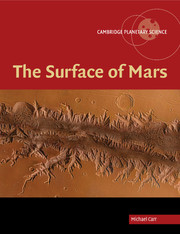2 - Impact craters
Published online by Cambridge University Press: 12 August 2009
Summary
Impact craters are the most distinctive landforms on solid planetary bodies other than the Earth. Almost every solid surface on every planet and satellite observed so far is cratered to some degree. Craters form as a result of high-velocity collisions between planetary bodies and comets and asteroids in orbit around the Sun. Impact velocities range from ten to a few tens of kilometers per second. The cratering rate today on all planetary bodies is very low. From the terrestrial crater record, Grieve and Shoemaker (1994) estimated that, on the Earth, the rate of formation of craters 20 km or larger is 5.6 × 10−15 km−2 yr−1 and that the rate is proportional to D−1.8 where D is the diameter of the crater. This implies that a 10 km diameter crater forms in the United States (10 million km2) every 5 Myr and a 1 km diameter crater forms every 80 kyr. Comparably low rates occur today on other planetary bodies of the inner Solar System. The present low rates are thought to have been typical for the last 3 Gyr (Neukum et al., 2001). The lunar record shows, however, that early in the history of the Solar System, prior to 3.5 Gyr ago, the rate of crater formation was dramatically higher. The rate 4 Gyr ago was 500 times higher than the roughly constant rate of the last 3 Gyr.
- Type
- Chapter
- Information
- The Surface of Mars , pp. 23 - 42Publisher: Cambridge University PressPrint publication year: 2007



